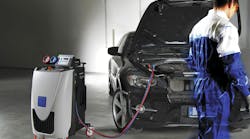The continued trend toward an older vehicle fleet presents unique opportunities for the automotive aftermarket, according to Mark Seng, global aftermarket practice leader for IHS Automotive, during a presentation to industry executives at the Automotive Aftermarket Products Expo (AAPEX) today in Las Vegas.
In the U.S., IHS Automotive anticipates the average light vehicle age will continue to rise but will do so more slowly than seen in the years following the 2008-2009 recession. While average age increased 15 percent from 2007-2014, it will increase only about 3 percent by 2020 from its current level of 11.5 years. This is roughly the same rate of increase that was seen in the five years prior to the recession.
This also suggests the “sweet spot” for the aftermarket will reflect changes as well. Vehicles new to five years old will grow 24 percent by 2020, while vehicles 6-11 years of age will decline 11 percent and vehicles 12-plus years old will grow 15 percent, according to IHS estimates. The fact that these oldest vehicles are growing in number is a great trend for the aftermarket repair business. In fact, by 2020, there will be approximately 76 million vehicles in operation (VIO) that are 16 years old or older, up from just 35 million in 2002.
VIO by the numbers
Global light vehicle population, or vehicles in operation (VIO), will experience substantial growth – 27 percent by 2021 – to 1.4 billion vehicles, according to IHS; and rise to two billion by 2040. VIO in the United States will also experience nice growth increasing in size by just more than 9 percent over the same time period. This is driven by both the huge gains in new vehicle sales – expected to hit 17.3 million units in 2015 - and the fact that vehicles are simply lasting longer than ever before.
Vehicle mix shifting, imports gaining
U.S. light vehicle sales continue to be dominated by compact CUVs, traditional mid-size sedans, traditional compacts and full-size pickups, which collectively represented more than 58 percent of new vehicle registrations in 2014. IHS Automotive expects the shift in favor of CUV designs to continue in the near term as well, while compact and mid-size sedans also maintain their dominance.
In addition, the mix of domestic versus import vehicles in operation in the U.S. is shifting, with import cars now representing 27.3 percent share, while their light truck counterparts represent 15.7 percent, an increase of nearly 10 percent collectively since 2007. Domestic cars are down nearly two percent in the timeframe, to 37.4 percent of VIO, while domestic light trucks represent 19.6 percent share of VIO, down nearly 8 percent since 2007.gaining 4.3 percent share.
This presents an opportunity for the aftermarket to build business strategies to service the growing numbers of import vehicles on U.S. roads. By 2020, IHS Automotive estimates imports will represent nearly 47 percent of the U.S. light vehicle VIO.
Global ‘mega’ platforms drive opportunities
The industry is looking forward to 100+ million sales by 2020, according to IHS Automotive forecasts. Additionally, by 2021, nearly 60 percent of light vehicle production is expected to be built on global platforms.
OEMs are expected to double production volume per platform by 2021 as well, Seng said. This trend includes a shift to more modular architecture and standardized components across vehicles sold around the world.
“Aftermarket suppliers must start planning now to understand global vehicle markets,” Seng said, “and identify where components will be the same and work to develop a global product and supply chain strategy to be competitive in the future.”
Subscribe to Aftermarket Business World and receive articles like this every month….absolutely free. Click here.


